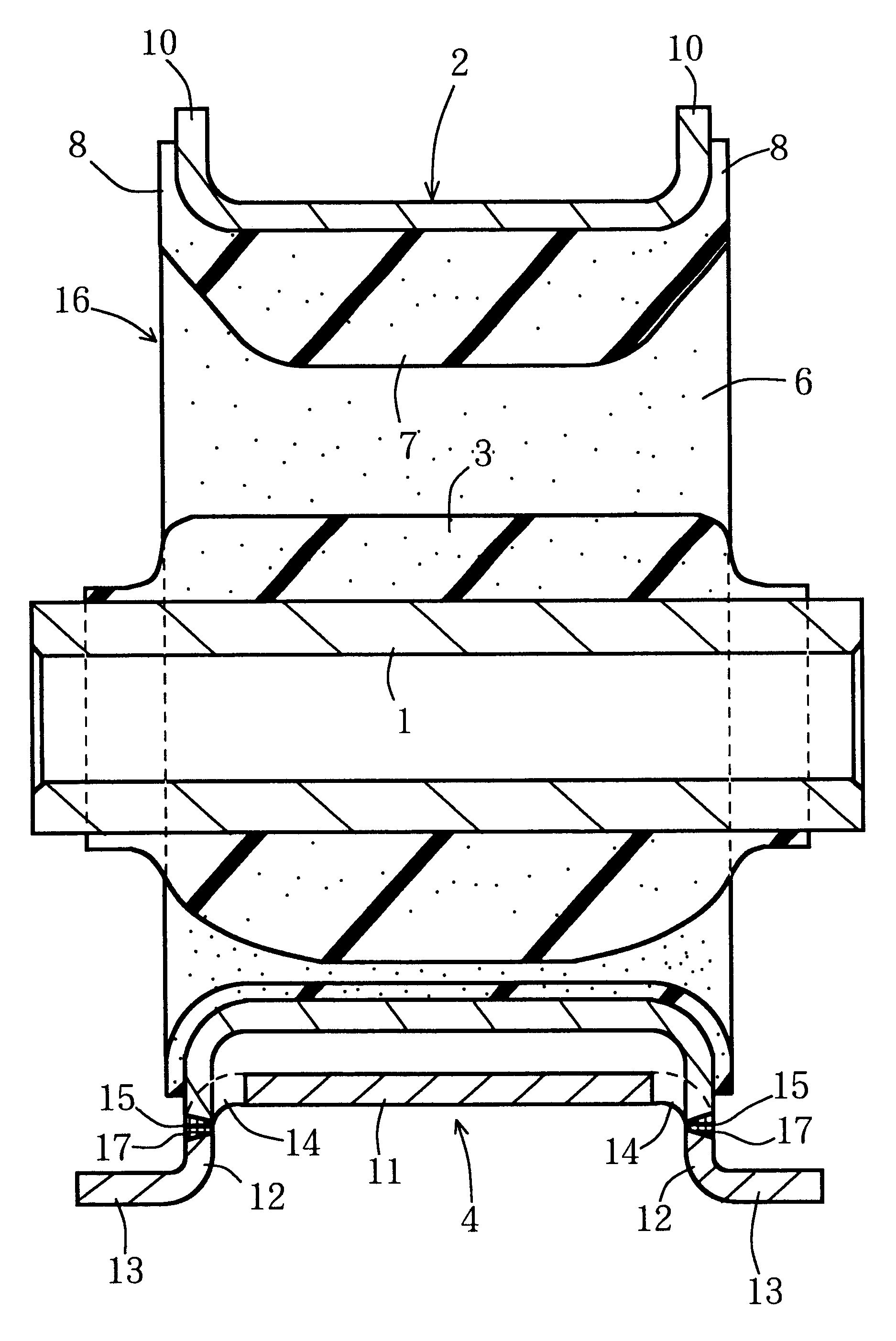Method of producing cylindrical vibration-proofing rubber device
a technology of vibration isolating rubber and cylindrical shape, which is applied in the direction of shock absorbers, manufacturing tools, machine supports, etc., can solve the problems of causing such a harmful damage as detaching rubber, and achieve the effects of convenient manufacturing, convenient manufacturing, and convenient welding
- Summary
- Abstract
- Description
- Claims
- Application Information
AI Technical Summary
Benefits of technology
Problems solved by technology
Method used
Image
Examples
first embodiment
FIGS. 1 through 5 are relating to the first embodiment adapting the present invention for a cylindrical engine mount.
In these Figures, a vibration isolating rubber device comprises an inner cylinder 1, an outer cylinder 2, a vibration isolating rubber 3 and a bracket 4, wherein the inner cylinder 1 is arranged eccentrically inside the outer cylinder 2, and the inner cylinder 1 and the outer cylinder 2 are connected by the vibration insulating rubber 3 having a substantially V-shaped arm portion 5 as shown in the front elevational view of FIG. 1.
Reference numeral 6 denotes an axially piercing space, 7 a stopper portion projecting from a remotest part of the outer cylinder away from the inner cylinder 1 toward the inner cylinder 1, and 8 a side stopper formed along the inside of the outer cylinder 2 and projecting axially longer than the outer cylinder 2.
A flange 10 is formed so as to bend radially outwardly on the axially opposite ends of the outer cylinder 2 and the side stopper 8 i...
second embodiment
FIGS. 6 through 9 show modified examples of such device made as a cylinder-type engine mount. Hereafter, the same functional parts are explained using the same reference numerals. First, the second embodiment in FIG. 6 shows a device in which an outer cylinder 2 thereof is composed of a wound pipe. In the drawing, (A) shows a front elevation of a vibration isolating functional member 16, (B) a front elevation of a bracket 4, (C) a cross-sectional view taken on line 6--6 of (B), and (D) a cross-sectional view of a connecting portion. In FIGS. 7 and 8 also, the similar drawings are shown in (A) to (D).
As is shown in (C) of FIG. 6, the cylinder 2 is laser-welded similarly as a former embodiment in a state that a confronting portion 20 having a slit is made to be in a welding region to the bracket 4. In the case, since width of the slit becomes a tightening margin when the confronting portion is welded with the bracket side connecting surface 15, namely the outer peripheral portion of t...
third embodiment
In FIG. 7, a bracket 4 is formed in a wound pipe-like shape provided with a cylindrical fitting portion 21 and the vibration insulating functional member 16 is inserted into the fitting portion 21. The axial end portion of the outer cylinder 2 is arranged to be an extending portion 22 which extends outwardly from a vibration isolating rubber 3 by more than 7.5 mm. Each peripheral end face of the extending portion 22 and the fitting portion 21 are evenly overlapped and an overlapped portion of both members is welded on the end face thereof. In FIG. 7, (C) shows a sectional view taken on line 7--7 in (B) of FIG. 7.
When using such a procedure, since the fitting portion 21 of the bracket 4 can be formed as a wound pipe-like shape, sticking ability of the bracket 4 with the vibration isolating functional member 16 can be improved by adjusting an opening degree of a confronting portion 23. Moreover, because the flange is not provided in this embodiment unlike the former one, it is possibl...
PUM
| Property | Measurement | Unit |
|---|---|---|
| thickness | aaaaa | aaaaa |
| thickness | aaaaa | aaaaa |
| speed | aaaaa | aaaaa |
Abstract
Description
Claims
Application Information
 Login to View More
Login to View More - R&D
- Intellectual Property
- Life Sciences
- Materials
- Tech Scout
- Unparalleled Data Quality
- Higher Quality Content
- 60% Fewer Hallucinations
Browse by: Latest US Patents, China's latest patents, Technical Efficacy Thesaurus, Application Domain, Technology Topic, Popular Technical Reports.
© 2025 PatSnap. All rights reserved.Legal|Privacy policy|Modern Slavery Act Transparency Statement|Sitemap|About US| Contact US: help@patsnap.com



